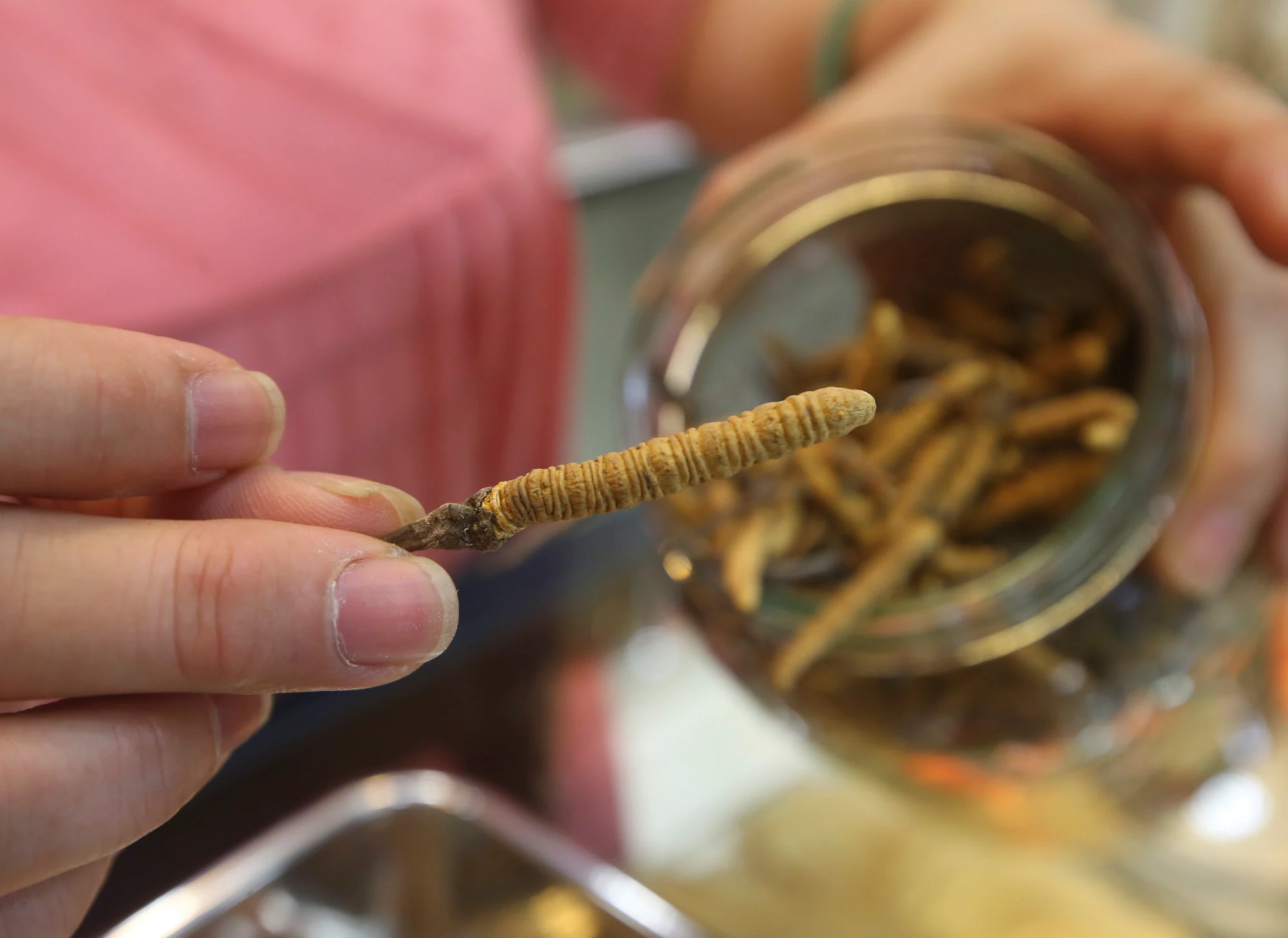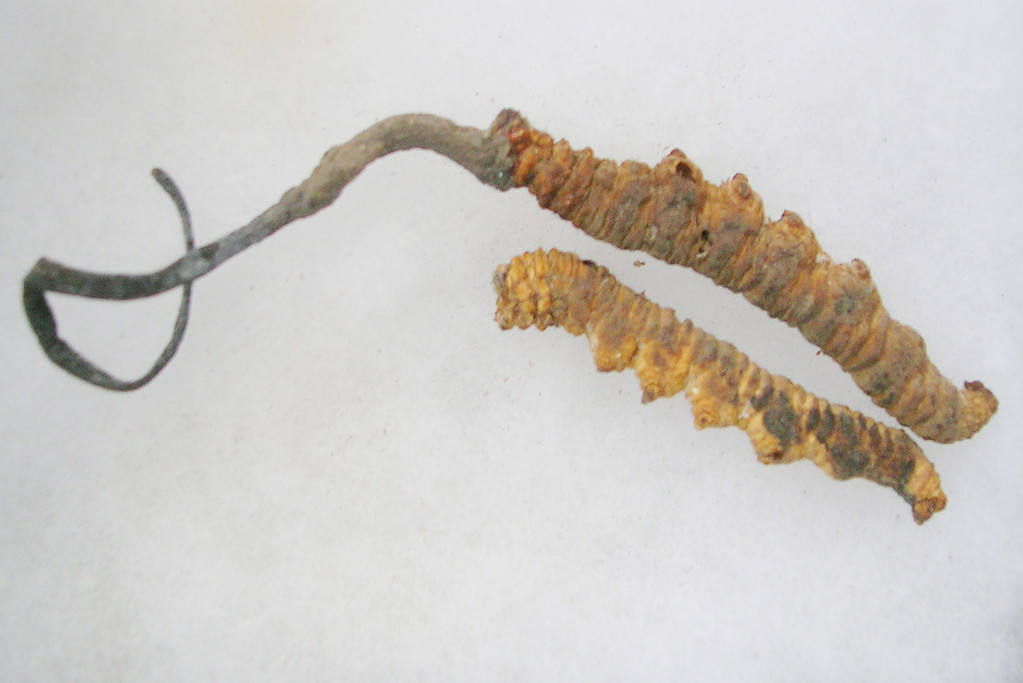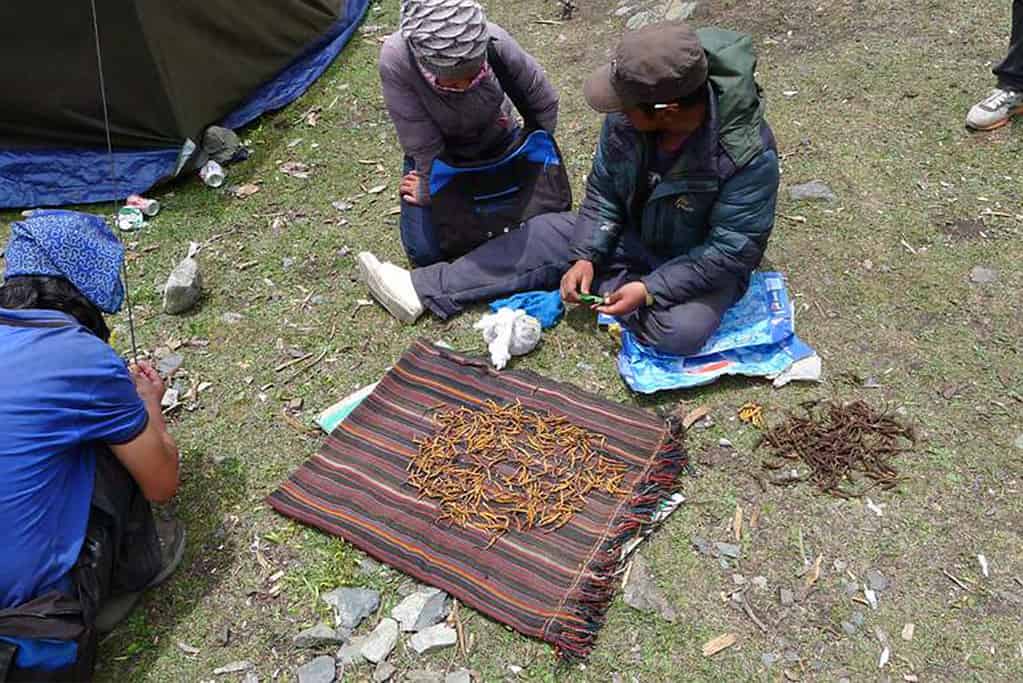
The Tibetan Plateau in the Himalayas is home to a fungus (Ophiocordyceps sinensis) that turns caterpillars into zombies. It’s part of the same Cordyceps fungal group that inspired the video game and later the HBO series The Last of Us. The caterpillar fungus is believed to be an aphrodisiac and is known as yartsa gunbu by locals.
Describing its aphrodisiacal properties, ancient Tibetan texts mention that men who consume yartsa are promised “the delights of thousands of beautiful women.” Others boast about the caterpillar fungus’ benefits to the immune system, using it to treat coughs and “strengthening the lungs”.
No scientific evidence has validated these claims thus far. Still, yartsa is in such high demand in some parts of the world that it is sold at a higher price than gold. For instance, a report from NPR reveals that people buy yartsa for as high as $2,000 per ounce in China where the fungus is also considered a status symbol.
“[Caterpillar fungus is] more likely to be found in a luxury shopping mall than a pharmacy. The perceived value of the resource is now so high that it’s a fashionable gift or party favor among China’s elite,” according to a report from National Geographic.
The growth and harvesting of yartsa gunbu


The English translation of yartsa gunbu is “winter worm summer grass,” to describe how the winter caterpillar becomes grass in summer.
During the summer season, the ghost moth caterpillars hibernate underground. This is when the airborne spores of O. sinensis invade their bodies, compelling them to climb upwards towards the soil’s surface, where the fungus then kills and consumes them.
The fungus manipulates the insect’s brain chemistry, forcing it to ascend to a height that optimizes the fungus’s growth conditions and spore distribution. Once above ground, the caterpillar dies and appears mummified because its exoskeleton turns pale. With the arrival of the spring season, the fungus begins to come out of the heads of the dead caterpillars in the form of a long stalk.
This mind control ensures the fungus’s life cycle continues. But for the locals of the Tibetan Plateau, this is just another harvesting season.
Once its stalk is visible on the ground, the world’s most expensive fungus is ready for harvesting. Many households in the Tibetan Plateau depend on earnings from harvesting this fungus, sometimes known as the ‘Viagra of the Himalayas’.
Geoff Childs and Namgyal Choedup, two researchers from Washington University in St. Louis (WUSTL) published a study in 2014 highlighting the sizable role yartsa plays in the Tibetan economy. Their research showed the good, bad, and ugly side of yartsa gunbu harvesting.
“With an eight-fold increase in value from ¥4,800 (~$32) to ¥40,000 (~$260) per pound yartsa gunbu has become the mainstay of household economies across the Tibetan Plateau. It fills an economic void in Tibetan areas of China that state-sponsored development projects, which tend to focus on infrastructure, do not always satisfy,” the study authors note.
“Tibetans are using the cash to improve their standard of living, and in some cases are reducing dependency on agro-pastoral activities by becoming entrepreneurs. Profits pay for everything from school supplies and DVDs to solar panels and gold jewelry,” they added.
However, it’s not just Tibetans. Yartsa gunbu has also brought prosperity to people living in the Himalayan villages of Nepal, India, and Bhutan.
The dark side of caterpillar fungi
Unfortunately, the high economic value of yartsa has also led to violent conflicts in the Tibetan Plateau. For instance, in 2014, a clash between two groups in Tibet over access to yartsa gunbu harvesting resulted in two deaths. And this was just one of the many disputes in the region that revolve around the caterpillar fungus.


“Earlier, we only had village meetings once or twice a year. Nowadays there are frequent meetings with more arguments between people, and more squabbles. People are becoming selfish,” a local man told Childs and Choedup.
Moreover, people are overexploiting the Himalayan grasslands for yartsa, which is accelerating the loss of the only habitat where the fungus grows.
Ophiocordyceps sinensis is already an endangered species. If the situation continues like this, it may soon go extinct. A study published in 2018 warned that overharvesting and climate change are causing the demise of the fungus.
“A collapse of the caterpillar fungus system under ongoing warming and high collection pressure would have serious implications throughout the Himalayan region,” the authors noted.
However, despite all these negative developments, there is still some hope. In their study, Child and Choedup also reveal the story of two Himalayan villages where people have devised strategies to achieve peaceful and sustainable harvesting of the caterpillar fungus.
Sustainable ways to harvest yartsa
The senior leaders in Nubri (a village in the highlands of Nepal) have developed a system that protects their yartsa. This system is based on religious and local beliefs that ensure stable income for all families in the village. By extension, it also prevents overexploitation of the caterpillar fungus.
Village leaders are central to the process. Each year, they decide on a date on which people are allowed to begin harvesting yartsa. From that date to the end of the harvesting season, each harvester must meet the leaders in person every week.
No villager is allowed to harvest before or after the scheduled harvesting season. If an individual violates this rule, they’re heavily fined. Since the harvesting area is far from the village, a person can’t harvest more than their quota and meet the leaders on the same day.
This system provides everyone an equal opportunity to collect the caterpillar fungus. The harvesters are also liable to pay taxes, and the funds are spent on development activities in the village.
Plus, the fungus is only harvested for a brief period. So yartsa and its natural environment have a whole year to recover from any loss incurred due to harvesting.
Moreover, Nubri people are prohibited from harvesting in certain sacred regions because of their religious beliefs. Such undisturbed areas become natural havens for O. sinensis spores.
However, Nubri isn’t the only village that has a sustainable yartsa harvesting system. People in the Tsum Valley of Nepal also follow a similar strategy with some changes. For instance, every individual born in the valley has an equal right to collect yartsa. However, any outsiders, including tourists and men who were not born in Tsum but settled here after marriage are prohibited from harvesting.
This prevents conflicts and overexploitation of yartsa, enabling the locals to keep their sacred natural resources protected and under their control.
The harvesters in Tsum also have to pay taxes. However, this money is used not only for building basic infrastructure in the village. It also goes towards constructing lodges that cater to foreign tourists, creating an additional income stream for the locals.
“In the case of Nubri and Tsum, management practices that were devised independent of state interference may prove to be sustainable over the long run,” Child and Choedup said.
The study has been published in The Journal of the Association for Nepal and Himalayan Studies.
Thanks for your feedback!

